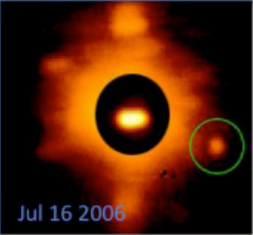
624 Hektor is the largest Jupiter trojan and the namesake of the Hektor family, with a highly elongated shape equivalent in volume to a sphere of approximately 225 to 250 kilometers diameter. It was discovered on 10 February 1907, by astronomer August Kopff at Heidelberg Observatory in southwest Germany, and named after the Trojan prince Hector, from Greek mythology. It has one small 12-kilometer sized satellite, Skamandrios, discovered in 2006.

Antiope is a double asteroid in the outer asteroid belt. It was discovered on October 1, 1866, by Robert Luther. In 2000, it was found to consist of two almost-equally-sized bodies orbiting each other. At average diameters of about 88 km and 84 km, both components are among the 500 largest asteroids. Antiope is a member of the Themis family of asteroids that share similar orbital elements.
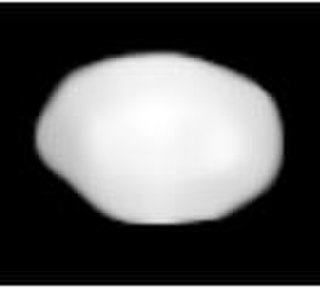
Eugenia is a large asteroid of the asteroid belt. It is famed as one of the first asteroids to be found to have a moon orbiting it. It was also the second triple asteroid to be discovered, after 87 Sylvia.
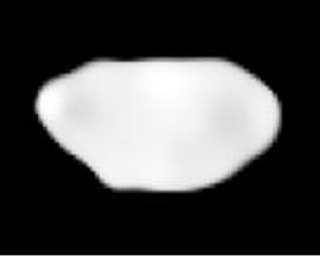
Sylvia is one of the largest asteroids. It is the parent body of the Sylvia family and member of Cybele group located beyond the main asteroid belt. Sylvia was the first asteroid known to possess more than one moon.

Camilla is one of the largest asteroids from the outermost edge of the asteroid belt, approximately 250 kilometers in diameter. It is a member of the Sylvia family and located within the Cybele group. It was discovered on 17 November 1868, by English astronomer Norman Pogson at Madras Observatory, India, and named after Camilla, Queen of the Volsci in Roman mythology. The X-type asteroid is a rare trinary asteroid with two minor-planet moons discovered in 2001 and 2016, respectively. It is elongated in shape and has a short rotation period of 4.8 hours.
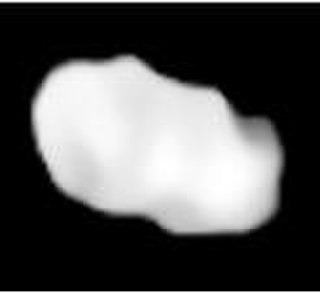
Elektra is a large outer main-belt asteroid and quadruple system with three minor-planet moons. It was discovered on 17 February 1873, by astronomer Christian Peters at Litchfield Observatory, New York, and named after Electra, an avenger in Greek mythology.
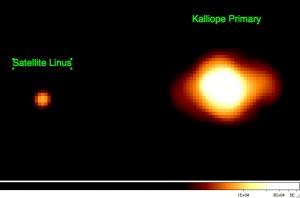
Kalliope is a large M-type asteroid from the asteroid belt discovered by J. R. Hind on 16 November 1852. It is named after Calliope, the Greek Muse of epic poetry. It is orbited by a small moon named Linus.

165 Loreley is a main-belt asteroid that was discovered by C. H. F. Peters on August 9, 1876, in Clinton, New York and named after the Lorelei, a figure in German folklore.
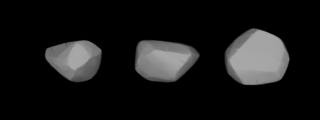
Nausikaa is a large main-belt S-type asteroid. It was discovered by Johann Palisa on February 17, 1879, at Pula, then in Austria, now in Croatia. The name derives from Nausicaä, a princess in Homer's Odyssey.

Ampella is a Main belt asteroid that was discovered by Alphonse Borrelly on June 13, 1879. The name seems to be the feminine form of Ampelos, a satyr and good friend of Dionysus in Greek mythology. It could also derive from the Ampelose, a variety of hamadryad. It is an S-type asteroid.

283 Emma is a large asteroid of the asteroid belt and the namesake of the Emma family. It was discovered by Auguste Charlois on 8 February 1889, in Nice, France. The reason for its name is unknown.

Huenna is a large asteroid orbiting in the asteroid belt. It is part of the Themis family, and thus a C-type asteroid and consequently composed mainly of carbonaceous material.
Gyptis, minor planet designation: 444 Gyptis, is a main-belt asteroid that was discovered by J. Coggia on March 31, 1899, in Marseilles. It is classified as a C-type asteroid and is probably composed of carbonaceous material. The spectra of the asteroid displays evidence of aqueous alteration.

617 Patroclus is a large binary Jupiter trojan asteroid. It is a dark D-type asteroid and a slow rotator, due to the 103-hour orbital period of its two components. It is one of five Jupiter trojan asteroids targeted by the Lucy space probe, and is scheduled for a flyby in 2033.
654 Zelinda is a minor planet orbiting the Sun that was discovered on 4 January 1908 by German astronomer August Kopff. On favorable oppositions, it can be as bright as magnitude 10.0, as on January 30, 2016.

679 Pax is a minor planet orbiting the Sun that was discovered by German astronomer August Kopff on January 28, 1909. It is named after Pax, a Roman goddess. It is orbiting the Sun with a period of 4.16 years and an eccentricity of 0.31.
804 Hispania is a minor planet orbiting the Sun. It was discovered from Barcelona (Spain) on 20 March 1915 by Josep Comas Solá (1868–1937), the first asteroid to be discovered by a Spaniard.
854 Frostia is a main-belt asteroid orbiting the Sun. It was discovered in 1916 by Sergei Ivanovich Belyavsky from Simeiz Observatory in Crimea and is named after Edwin Brant Frost, an American astronomer. This asteroid measures approximately 8.4 km (5.2 mi) in diameter.
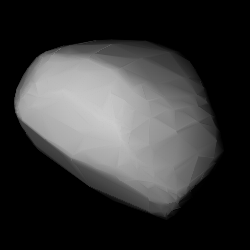
3749 Balam is a stony Flora asteroid and rare trinary system orbiting in the inner regions of asteroid belt. It also forms a secured asteroid pair with sub-kilometer sized asteroid (312497) 2009 BR60. Balam was discovered on 24 January 1982, by American astronomer Edward Bowell at Lowell's Anderson Mesa Station near Flagstaff, Arizona, and received the prov. designation 1982 BG1. It was named after Canadian astronomer David Balam. Balam measures approximately 4.1 kilometers (2.5 miles) in diameter. Its two minor-planet moons have an estimated diameter of 1.66 and 1.84 kilometers, respectively.
4674 Pauling, provisional designation 1989 JC, is a spheroidal binary Hungaria asteroid from the innermost regions of the asteroid belt, approximately 4.5 kilometers in diameter. It was discovered by American astronomer Eleanor Helin at the U.S. Palomar Observatory, California, on 2 May 1989, and named after the American chemist and Nobel laureate Linus Pauling.















